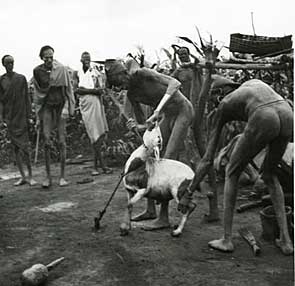Nuer Religion
From: "The Nuer of the Upper Nile River", in Profiles in Ethnology, by Elman R. Service
There is a great fear of the ghosts of the dead. Shortly after a death, the corpse is buried in the fetal position in a grave about four feet deep. A cowhide is wrapped around the body, but no possessions are placed in the grave. Relatives and age mates then allow their hair to grow and put aside their body ornaments. The most important ceremony takes place at the end of the mourning period, some six months after the death of a man and three months after the death of a woman. Bullocks are killed for a feast, and the assemblage is ritually sprinkled with milk. After the feast, the mourners shave their heads and resume wearing their customary ornaments. The main purpose of the ceremony is to placate the spirit of the deceased so that it will make no attempt to take its wife or husband, children, and cattle.
If a person is struck by lightning or dies suddenly without a previous illness, it is believed that the Sky God has removed the spirit and taken it into the sky. A mourning period is not held, inasmuch as the spirit has not lingered in the vicinity during the usual period; the sacrifice of cattle is made immediately after the burial. The Nuer do not betray great sorrow because of a death. It is the will of the Sky God if a person is taken, and to show emotion would be to complain against the action.
There are several Sky Gods or spirits. The most powerful is Deng, who is associated with sickness. Certain others are gods of war, hunting, thunder and lightning, and so on. There are also certain earth spirits, many of which are related to species of birds or animals and which function as totems of lineages. Birds are particularly sacred totems of the Nuer, which is apparently the reason that the people will not eat the flesh or eggs of birds.
There is a sense, however, in which there are no particular gods at all. The Nuer hold a conception of Kwoth, a generalized Spirit or God-essence, reminiscent of the Polynesian mana; and the various named gods and totemic spirits are manifestations of the spiritual essence and not Kwoth themselves. Thus, in a philosophical sense the Nuer are monotheistic, but in terms of action, such as the practice of sacrifice, they seem polytheistic. Perhaps it is most appropriate to call them merely theistic.
Certain men claim special powers of healing and prognostication as a result of possession of one of the totemic spirits. Particular healers are known for their specialties; one is good at divining, another at curing constipation or headache. Divining is accomplished by reading signs, most typically by interpreting the pattern in the fall of mussel shells thrown against the side of a gourd rattle. Curing involves the world-wide technique of massage and the extraction of a foreign object from the patient's afflicted part. Some shamans have acquired wide influence and are known as prophets [the author is not using this term as it is normally used in cultural anthropology], being possessed of mightier spirit helpers than the ordinary diviner. Some of these men function as rain makers, conducting ceremonies that involve the sacrifice of animals to the thunder spirit. Rain makers are very important ritual functionaries among the neighboring Dinka and Shilluk, but less so among the Nuer.

Morton, Chris. "Nuer sheep sacrifice" 1935 Southern Sudan Project (in development). 03 Jan. 2006. Pitt Rivers Museum.
[Note: The Nuer sacrificed animals for a variety of religious rituals, and as part of the Gar ceremony.]
The Nuer sometimes raise pyramids of considerable size in honor of a particular god-spirit. One of these is about 50 feet high and 300 feet in circumference. These monuments are built of baked earth and ashes and ringed around with upright elephant tusks. The idea of pyramids may have diffused in ancient times from Egypt; but the Nuer pyramids, in contrast to those of the Egyptians, are not burial mausoleums, nor are they built with conscripted or forced labor.
The Nuer also have a conception of evil eye--a person of some supernatural power who maliciously causes damage to people by looking at them. Allied to this is the notion of witches, particularly a kind of ghoul who secretly performs rites over the bodies of the newly dead in order to gain control over the souls of the surviving relatives. As is so common in human society, people who are disliked or who commit antisocial acts that arouse fear are sometimes accused of witchcraft, and it is said that in the past such witches were killed with the consent of the community.
The Nuer have many traditions or myths of their origin as a people and of the beginnings of their customs. A common feature of many of them is the idea that the original progenitors of the Nuer descended from the sky down to a very large tree and then to the ground, where they became mankind. The first descendants were all siblings of course, but a culture hero,Gaa, divided them into two groups and decreed that they must marry into their opposite group but not into their own. By a process of growth and fission through generations, the two lineages branched into many, the more closely related ones to be conceived as clans.
|